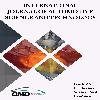Modelling and fault diagnosis of lithium-ion battery for electric powertrain
Modelling and fault diagnosis of lithium-ion battery for electric powertrain
Battery ageing, Battery pack faults, Cell relaxation time, Equivalent circuit, Lithium-ion battery modelling Matlab-Simulink, State of charge, WLTC,
___
- [1] O’Connell A, Pavlenko N, Bieker G, Searle S. A comparison of the life-cycle greenhouse gas emissions of european heavy-duty vehicles and fuels. 2023 févr. (The International Council on Clean Transportation).
- [2] Regulation (EU) 2019/631 of the European Parliament and of the council of 17 April 2019 setting CO2 emission perfor-mance standards for new passenger cars and for new light commercial vehicles, and repealing Regulations (EC) No 443/2009 and (EU) No 510/2011. 2019. (Official Journal of the European Union).
- [3] Liu K, Li K, Peng Q, Zhang C. A brief review on key tech-nologies in the battery management system of electric vehi-cles. Front Mech Eng. 2019;14(1):47‑64.
- [4] Singh KV, Bansal HO, Singh D. A comprehensive review on hybrid electric vehicles: architectures and components. J Mod Transport. 2019;27(2):77‑107.
- [5] Hu X, Xu L, Lin X, Pecht M. Battery Lifetime Prognostics. Joule. 2020;4(2):310‑46.
- [6] Ouyang T, Xu P, Chen J, Lu J, Chen N. Improved parameters identification and state of charge estimation for lithium-ion battery with real-time optimal forgetting factor. Electrochim Acta. 2020;353:136576.
- [7] Fellner C, Newman J. High-power batteries for use in hybrid vehicles. J Power Sources. 2000;85(2):229‑36.
- [8] Miao Y, Hynan P, von Jouanne A, Yokochi A. Current Li-Ion Battery Technologies in Electric Vehicles and Opportunities for Advancements. Energies. 2019;12(6):1074.
- [9] Zeng X, Li M, Abd El‐Hady D, Alshitari W, Al‐Bogami AS, Lu J, et al. Commercialization of Lithium Battery Technolo-gies for Electric Vehicles. Adv Energy Mater. juill 2019;9(27):1900161.
- [10] Redondo-Iglesias E, Venet P, Pelissier S. Modélisation du vieillissement calendaire de cellules lithium-ion (gra-phite/LiFePO4) avec prise en compte de la dérive de leur état de charge. In: Symposium de Génie Electrique (SGE’16). Grenoble, France; 2016.
- [11] Badey Q. Étude des mécanismes et modélisation du vieillis-sement des batteries lithium-ion dans le cadre d’un usage automobile. [Paris XI]: Université Paris-Sud; 2012.
- [12] Jalkanen K, Karppinen J, Skogström L, Laurila T, Nisula M, Vuorilehto K. Cycle aging of commercial NMC/graphite pouch cells at different temperatures. Appl Energy. sept 2015;154:160‑72.
- [13] Gao Y, Jiang J, Zhang C, Zhang W, Ma Z, Jiang Y. Lithium-ion battery aging mechanisms and life model under different charging stresses. J Power Sources. 2017;356:103‑14.
- [14] Eom SW, Kim MK, Kim IJ, Moon SI, Sun YK, Kim HS. Life prediction and reliability assessment of lithium secondary batteries. J Power Sources. 2007;174(2):954‑8.
- [15] Ganjeizadeh F, Tapananon T, Lei H. Predicting Reliability of Lithium Ion Batteries. International Journal of Engineering Research and Technology. 2014;3(8):1189‑92.
- [16] Lee S, Kim J, Lee J, Cho BH. State-of-charge and capacity estimation of lithium-ion battery using a new open-circuit voltage versus state-of-charge. J Power Sources. 2008;185(2):1367‑73.
- [17] He H, Xiong R, Fan J. Evaluation of Lithium-Ion Battery Equivalent Circuit Models for State of Charge Estimation by an Experimental Approach. Energies. 2011;4(4):582‑98.
- [18] Madani S, Schaltz E, Knudsen Kær S. An Electrical Equiva-lent Circuit Model of a Lithium Titanate Oxide Battery. Batte-ries. 2019;5(1):31.
- [19] Li A. Analyse expérimentale et modélisation d’éléments de batterie et de leurs assemblages : application aux véhicules électriques et hybrides [Energie électrique]. Université Claude Bernard - Lyon I; 2013.
- [20] Łebkowski A. Temperature, Overcharge and Short-Circuit Studies of Batteries used in Electric Vehicles. Prz Elektrotech. 2017;1(5):69‑75.
- [21] Amine K, Liu J, Belharouak I. High-temperature storage and cycling of C-LiFePO4/graphite Li-ion cells. Electrochem Commun. 2005;7(7):669‑73.
- [22] Lin X, Perez HE, Mohan S, Siegel JB, Stefanopoulou AG, Ding Y, et al. A lumped-parameter electro-thermal model for cylindrical batteries. J Power Sources. juill 2014;257:1‑11.
- [23] Keil P, Schuster SF, Wilhelm J, Travi J, Hauser A, Karl RC, et al. Calendar Aging of Lithium-Ion Batteries: I. Impact of the Graphite Anode on Capacity Fade. J Electrochem Soc. 2016;163(9):A1872‑80.
- [24] Ben-Marzouk M, Chaumond A, Redondo-Iglesias E, Montaru M, Pélissier S. Experimental Protocols and First Results of Calendar and/or Cycling Aging Study of Lithium-Ion Batter-ies – the MOBICUS Project. WEVJ. 24 juin 2016;8(2):388‑97.
- [25] Yuksel T, Michalek J. Development of a Simulation Model to Analyze the Effect of Thermal Management on Battery Life. In 2012. p. 2012-01‑0671.
- [26] Redondo Iglesias E. Étude du vieillissement des batteries lithium-ion dans les applications « “véhicule électrique” »: combinaison des effets de vieillissement calendaire et de cy-clage. Université de Lyon 1; 2017.
- [27] Zarrin H, Farhad S, Hamdullahpur F, Chabot V, Yu A, Fowler M, et al. Effects of Diffusive Charge Transfer and Salt Con-centration Gradient in Electrolyte on Li-ion Battery Energy and Power Densities. Electrochimica Acta. avr 2014;125:117‑23.
- [28] Karthikeyan DK, Sikha G, White RE. Thermodynamic model development for lithium intercalation electrodes. Journal of Power Sources. déc 2008;185(2):1398‑407.
- Yayın Aralığı: 4
- Başlangıç: 2016
- Yayıncı: Otomotiv Mühendisleri Derneği
Karthikeyan SUBRAMANİAN, Annamalai KANDASWAMY
Modelling and fault diagnosis of lithium-ion battery for electric powertrain
Adrien SOLOY, Thomas BARTOLİ, Fatima HAİDAR
Kumaran P, Natarajan S, Sudesh Kumar M P, Mohamed RASHİD, Nithish S
Christian MANN, Patrick SİEGFRİED, Alex MİCHEL
Bora DEMİRCİ, Uğur DEMİR, Gazi AKGÜN, Alper YILDIRIM, Caner AKUNER
A brief survey on cooperative intelligent transportation systems and applications
Gazi Başar KOCABAŞ, Erhan CETİN, Senai YALCİNKAYA, Yusuf ŞAHİN
Structural Optimization of the Brake Pedal using Artificial Intelligence
